| Revision as of 15:58, 12 June 2020 edit176.253.62.89 (talk) →In popular culture: mentioned Julius CaeserTag: Visual edit← Previous edit | Revision as of 16:06, 12 June 2020 edit undoGauravagarwal0406 (talk | contribs)9 edits →In popular cultureTag: Visual editNext edit → | ||
| Line 353: | Line 353: | ||
| * The golden drachma is the main unit of currency in ] '']'' fantasy adventure novel series, as well as its spinoff '']'', the latter of which also features the Roman ]. | * The golden drachma is the main unit of currency in ] '']'' fantasy adventure novel series, as well as its spinoff '']'', the latter of which also features the Roman ]. | ||
| * The drachma is used in the video game '']'', set in ], as the currency used by the player to purchase weapons, outfits and mounts. It is also used in the subsequent game '']'', set in ]. | * The drachma is used in the video game '']'', set in ], as the currency used by the player to purchase weapons, outfits and mounts. It is also used in the subsequent game '']'', set in ]. | ||
| *The drachma is also mentioned in William Shakespeare's ] in Mark Antony's famous "]<ref>https://shakespeare-navigators.com/JC_Navigator/Julius_Caesar_Act_3_Scene_2.html# |
*The drachma is also mentioned in William Shakespeare's ] in Mark Antony's famous "]<ref>https://shakespeare-navigators.com/JC_Navigator/Julius_Caesar_Act_3_Scene_2.html#241</ref>" speech. | ||
| ==See also== | ==See also== | ||
Revision as of 16:06, 12 June 2020
"Drachma" redirects here. For the moth genus, see Drachma (moth).This article contains special characters. Without proper rendering support, you may see question marks, boxes, or other symbols.
The drachma (Template:Lang-el Greek pronunciation: [ðraxˈmi], Greek pronunciation: [drakʰmέː]; pl. drachmae or drachmas) was the currency used in Greece during several periods in its history:
- An ancient Greek currency unit issued by many Greek city states during a period of ten centuries, from the Archaic period throughout the Classical period, the Hellenistic period up to the Roman period under Greek Imperial Coinage.
- Three modern Greek currencies, the first introduced in 1832 by the Greek King Otto (Όθων) and the last replaced by the euro in 2001 (at the rate of 340.75 drachmae to the euro). The euro did not begin circulating until 2001 but the exchange rate was fixed on 19 June 2000, with legal introduction of the euro taking place in January 2001.
It was also a small unit of weight.
Ancient drachma
Drachma in the Greek world Above: Six rod-shaped obeloi (oboloi) displayed at the Numismatic Museum of Athens, discovered at Heraion of Argos. Below: grasp of six oboloi forming one drachma
Above: Six rod-shaped obeloi (oboloi) displayed at the Numismatic Museum of Athens, discovered at Heraion of Argos. Below: grasp of six oboloi forming one drachma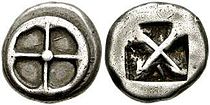 Athenian silver didrachm of "heraldic type" from the time of Peisistratos, 545–510 BC. Obverse: Four-spoked wheel. Reverse: Incuse square, divided diagonally
Athenian silver didrachm of "heraldic type" from the time of Peisistratos, 545–510 BC. Obverse: Four-spoked wheel. Reverse: Incuse square, divided diagonally Greek drachma of Aegina. Obverse: Land Chelone / Reverse: ΑΙΓ(INA) and dolphin. The oldest Aegina chelone coins depicted sea turtles and were minted ca. 700–550 BC.
Greek drachma of Aegina. Obverse: Land Chelone / Reverse: ΑΙΓ(INA) and dolphin. The oldest Aegina chelone coins depicted sea turtles and were minted ca. 700–550 BC.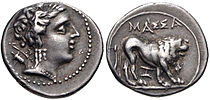 Silver tetrobol (4/6 of drachma) from Massalia. Obverse: Artemis wearing stephane. Reverse: ΜΑΣΣΑ (of Massalians), lion standing right.
Silver tetrobol (4/6 of drachma) from Massalia. Obverse: Artemis wearing stephane. Reverse: ΜΑΣΣΑ (of Massalians), lion standing right. Tetradrachm from Olympia. 105th Olympiad, 360 BC. Obverse: Head of Zeus. Reverse: The nymph Olympia, inscription: ΟΛΥΜΠΙΑ.
Tetradrachm from Olympia. 105th Olympiad, 360 BC. Obverse: Head of Zeus. Reverse: The nymph Olympia, inscription: ΟΛΥΜΠΙΑ. Silver Drachma of Philip III Arrhidaios, minted at Babylon. Obverse: Head of Herakles. Reverse: Zeus Aëtophoros.
Silver Drachma of Philip III Arrhidaios, minted at Babylon. Obverse: Head of Herakles. Reverse: Zeus Aëtophoros.
The name drachma is derived from the verb δράσσομαι (drássomai, "(I) grasp"). It is believed that the same word with the meaning of "handful" or "handle" is found in Linear B tablets of the Mycenean Pylos. Initially a drachma was a fistful (a "grasp") of six oboloí or obeloí (metal sticks, literally "spits") used as a form of currency as early as 1100 BC and being a form of "bullion": bronze, copper, or iron ingots denominated by weight. A hoard of over 150 rod-shaped obeloi was uncovered at Heraion of Argos in Peloponnese. Six of them are displayed at the Numismatic Museum of Athens.
It was the standard unit of silver coinage at most ancient Greek mints, and the name obol was used to describe a coin that was one-sixth of a drachma. The notion that drachma derived from the word for fistful was recorded by Herakleides of Pontos (387–312 BC) who was informed by the priests of Heraion that Pheidon, king of Argos, dedicated rod-shaped obeloi to Heraion. Similar information about Pheidon's obeloi was also recorded at the Parian Chronicle.
Ancient Greek coins normally had distinctive names in daily use. The Athenian tetradrachm was called owl, the Aeginetic stater was called chelone, the Corinthian stater was called hippos (horse) and so on. Each city would mint its own and have them stamped with recognizable symbols of the city, known as badge in numismatics, along with suitable inscriptions, and they would often be referred to either by the name of the city or of the image depicted. The exact exchange value of each was determined by the quantity and quality of the metal, which reflected on the reputation of each mint.
Among the Greek cities that used the drachma were: Abdera, Abydos, Alexandria, Aetna, Antioch, Athens, Chios, Cyzicus, Corinth, Ephesus, Eretria, Gela, Catana, Kos, Maronia, Naxos, Pella, Pergamum, Rhegion, Salamis, Smyrni, Sparta, Syracuse, Tarsus, Thasos, Tenedos, Troy and more.
The 5th century BC Athenian tetradrachm ("four drachmae") coin was perhaps the most widely used coin in the Greek world prior to the time of Alexander the Great (along with the Corinthian stater). It featured the helmeted profile bust of Athena on the obverse (front) and an owl on the reverse (back). In daily use they were called γλαῦκες glaukes (owls), hence the proverb Γλαῦκ’ Ἀθήναζε, 'an owl to Athens', referring to something that was in plentiful supply, like 'coals to Newcastle'. The reverse is featured on the national side of the modern Greek 1 euro coin.
Drachmae were minted on different weight standards at different Greek mints. The standard that came to be most commonly used was the Athenian or Attic one, which weighed a little over 4.3 grams.
After Alexander the Great's conquests, the name drachma was used in many of the Hellenistic kingdoms in the Middle East, including the Ptolemaic kingdom in Alexandria and the Parthian Empire based in what is modern-day Iran. The Arabic unit of currency known as dirham (Template:Lang-ar), known from pre-Islamic times and afterwards, inherited its name from the drachma or didrachm (δίδραχμον, 2 drachmae); the dirham is still the name of the official currencies of Morocco and the United Arab Emirates. The Armenian dram (Template:Lang-hy) also derives its name from the drachma.
Value
It is difficult to estimate comparative exchange rates with modern currency because the range of products produced by economies of centuries gone by were different from today, which makes purchasing power parity (PPP) calculations very difficult; however, some historians and economists have estimated that in the 5th century BC a drachma had a rough value of 25 U.S. dollars (in the year 1990 – equivalent to 46.50 USD in 2015), whereas classical historians regularly say that in the heyday of ancient Greece (the fifth and fourth centuries) the daily wage for a skilled worker or a hoplite was one drachma, and for a heliast (juror) half a drachma since 425 BC.
Modern commentators derived from Xenophon that half a drachma per day (360 days per year) would provide "a comfortable subsistence" for "the poor citizens" (for the head of a household in 355 BC). Earlier in 422 BC, we also see in Aristophanes (Wasps, line 300–302) that the daily half-drachma of a juror is just enough for the daily subsistence of a family of three.
A modern person might think of one drachma as the rough equivalent of a skilled worker's daily pay in the place where they live, which could be as low as US$1, or as high as $100, depending on the country.
Fractions and multiples of the drachma were minted by many states, most notably in Ptolemaic Egypt, which minted large coins in gold, silver and bronze.
Notable Ptolemaic coins included the gold pentadrachm and octadrachm, and silver tetradrachm, decadrachm and pentakaidecadrachm. This was especially noteworthy as it would not be until the introduction of the Guldengroschen in 1486 that coins of substantial size (particularly in silver) would be minted in significant quantities.
For the Roman successors of the drachma, see Roman provincial coins.
Denominations of Ancient Greek drachma
The weight of the silver drachma was approximately 4.3 grams or 0.15 ounces, although weights varied significantly from one city-state to another. It was divided into six obols of 0.72 grams, which were subdivided into four tetartemoria of 0.18 grams, one of the smallest coins ever struck, approximately 5–7 mm in diameter.
Historic currency divisions
- 8 chalkoi = 1 obolus
- 6 oboloi = 1 drachma
- 70 drachmae = 1 mina (or mna), later 100 drachmae = 1 mina
- 60 minae = 1 Athenian Talent (Athenian standard)
Minae and talents were never actually minted: they represented weight measures used for commodities (e.g. grain) as well as metals like silver or gold. The New Testament mentions both didrachma and, by implication, tetradrachma in context of the Temple tax. Luke's Gospel includes a parable told by Jesus of a woman with 10 drachmae, who lost one and searched her home until she found it.
Modern drachma
| Δραχμή | |
|---|---|
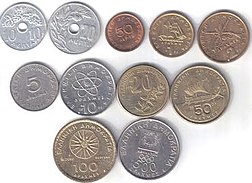 Modern drachma coins; Top row, left to right: 10-lepton coin, 20-lepton coin, 50-lepton coin, 1-drachma coin, 2-drachma coin. Middle row, left to right: 5-drachma coin, 10-drachma coin, 20-drachma coin, 50-drachma coin. Bottom row, left to right: 100-drachma coin, 500-drachma coin. Modern drachma coins; Top row, left to right: 10-lepton coin, 20-lepton coin, 50-lepton coin, 1-drachma coin, 2-drachma coin. Middle row, left to right: 5-drachma coin, 10-drachma coin, 20-drachma coin, 50-drachma coin. Bottom row, left to right: 100-drachma coin, 500-drachma coin. | |
| ISO 4217 | |
| Code | GRD |
| Unit | |
| Symbol | Δρχ., Δρ. or ₯ |
| Denominations | |
| Superunit | |
| 100 | mina |
| 6000 | talent |
| Subunit | |
| 1/100 | leptοn (Λ.) |
| 1/10000 | defteroleptοn |
| Banknotes | |
| Freq. used | 200, 1000, 5000, 10,000 Δρ. |
| Rarely used | 50, 100, 500 Δρ |
| Coins | |
| Freq. used | 5, 10, 20, 50, 100, 500 Δρ. |
| Rarely used | 10 Λ., 20 Λ., 50 Λ., 1 and 2 Δρ. |
| Demographics | |
| User(s) | None, previously: Greece |
| Issuance | |
| Central bank | Bank of Greece and Greek mint |
| Website | www |
| Valuation | |
| Inflation | 3.1% (2000) |
| Source | Grecian.net |
| EU Exchange Rate Mechanism (ERM) | |
| Since | March 1998 |
| Fixed rate since | 19 June 2000 |
| Replaced by euro, non cash | 1 January 2001 |
| Replaced by euro, cash | 1 January 2002 |
| 1 € = | 340.75 Δρ. |

First modern drachma
The drachma was reintroduced in May 1832, shortly before the establishment of the modern state of Greece (with the exception of the subdivision Taurus). It replaced the phoenix at par. The drachma was subdivided into 100 lepta.
Coins
The first coinage consisted of copper denominations of 1, 2, 5 and 10 lepta, silver denominations of 1⁄4, 1⁄2, 1 and 5 drachmae and a gold coin of 20 drachmae. The drachma coin weighed 4.5 g and contained 90% silver, with the 20-drachma coin containing 5.8 g of gold.
In 1868, Greece joined the Latin Monetary Union and the drachma became equal in weight and value to the French franc. The new coinage issued consisted of copper coins of 1, 2, 5 and 10 lepta, with the 5- and 10-lepta coins bearing the names obolos (ὀβολός) and diobolon (διώβολον), respectively; silver coins of 20 and 50 lepta, 1, 2 and 5 drachmae and gold coins of 5, 10 and 20 drachmae. (Very small numbers of 50- and 100-drachma coins in gold were also issued.)
In 1894, cupro-nickel 5-, 10- and 20-lepta coins were introduced. No 1-lepton or 2-lepta coin had been issued since the late 1870s. Silver coins of 1 and 2 drachmae were last issued in 1911, and no coins were issued between 1912 and 1922, during which time the Latin Monetary Union collapsed due to World War I.
Between 1926 and 1930, a new coinage was introduced for the new Hellenic Republic, consisting of cupro-nickel coins in denominations of 20 lepta, 50 lepta, 1 drachma, and 2 drachmae; nickel coins of 5 drachmae; and silver coins of 10 and 20 drachmae. These were the last coins issued for the first modern drachma, and none were issued for the second.
Notes

Notes were issued by the National Bank of Greece from 1841 until 1928. The Bank of Greece issued notes from 1928 until 2001, when Greece joined the Euro. Early denominations ranged from 10 to 500 drachmae. Smaller denominations (1, 2, 3 and 5 drachmae) were issued from 1885, with the first 5-drachma notes being made by cutting 10-drachma notes in half.
When Greece finally achieved its independence from the Ottoman Empire in 1828, the phoenix was introduced as the monetary unit; its use was short-lived, however, and in 1832 the phoenix was replaced by the drachma, adorned with the image of King Otto of Greece, who reigned as modern Greece's first king from 1832 to 1862. The drachma was divided into 100 lepta. In 2002 the drachma ceased to be legal tender after the euro, the monetary unit of the European Union, became Greece's sole currency.
From 1917 to 1920, the Greek government took control of issuing small change notes under Law 991/1917. During that time, the government issued denominations of 10 & 50 lepta, and 1, 2 & 5 drachmae. The National Bank of Greece introduced 1000-drachma notes in 1901, and the Bank of Greece introduced 5,000-drachma notes in 1928. The economic depression of the 1920s affected many nations around the globe, including Greece. In 1922, the Greek government issued a forced loan in order to finance their growing budget deficit. On April 1, 1922, the government decreed that half of all bank notes had to be surrendered and exchanged for 6.5% bonds. The notes were then cut in half, with the portion bearing the Greek crown standing in for the bonds while the other half was exchanged for a new issue of central bank notes at half the original value. The Greek government again issued notes between 1940 and 1944, in denominations ranging from 50 lepta to 20 drachmae.

During the German–Italian occupation of Greece from 1941 to 1944, catastrophic hyperinflation and Nazi looting of the Greek treasury caused much higher denominations to be issued, culminating in 100,000,000,000-drachma notes in 1944. The Italian occupation authorities in the Ionian Islands printed their own currency (Ionian drachma).
Second modern drachma
On 11 November 1944, following the liberation of Greece from Nazi Germany, old drachma were exchanged for new ones at the rate of 50,000,000,000 to 1. Only paper money was issued for the second drachma. The government issued notes of 1, 5, 10 and 20 drachma, with the Bank of Greece issuing 50-, 100-, 500-, 1000-, 5000-, and 10,000-drachma notes. This drachma also suffered from high inflation. The government later issued 100-, 500-, and 1000-drachma notes, and the Bank of Greece issued 20,000-and 50,000-drachma notes.
Third modern drachma
On 9 April 1953, in an effort to halt inflation, Greece joined the Bretton Woods system. On 1 May 1954, the drachma was revalued at a rate of 1000 to 1, and small change notes were abolished for the last time. The third drachma assumed a fixed exchange rate of 30 drachmae per dollar until 20 October 1973: over the next 25 years, the official exchange rate gradually declined, reaching 400 drachmae per dollar. On 1 January 2002, the Greek drachma was officially replaced as the circulating currency by the euro, and it has not been legal tender since 1 March 2002.
Third modern drachma coins
The first issue of coins minted in 1954 consisted of holed aluminium 5-, 10- and 20-lepton pieces, with 50-lepton, 1-, 2-, 5- and 10-drachma pieces in cupro-nickel. A silver 20-drachma piece was issued in 1960, replacing the 20-drachma banknote, and also minted only in collector sets in 1965. Coins in denominations from 50 lepta to 20 drachmae carried a portrait of King Paul (1947–1964). New coins were introduced in 1966, ranging from 50 lepta to 10 drachmae, depicting King Constantine II (1964–1974). A silver 30 drachma coin for the centennial of Greece's royal dynasty was minted in 1963. The following year a non-circulating coin of this value was produced to commemorate the royal wedding. The reverse of all coins was altered in 1971 to reflect the military junta which was in power from 1967 to 1974. This design included a soldier standing in front of the flames of the rising phoenix.
A 20-drachmae coin in cupro-nickel with an image of Europa on the obverse was issued in 1973. In the late 1973, several new coin types were introduced: unholed aluminium (10 and 20 lepta), nickel-brass (50 lepta, 1 drachma, and 2 drachmae) and cupro-nickel (5, 10, and 20 drachmae). These provisional coins carried the design of the phoenix rising from the flame on the obverse, and used the country's new designation as the "Hellenic Republic", replacing the coins also issued in 1973 as the Kingdom of Greece with King Constantine II's portrait. A new series of all 8 denominations was introduced in 1976 carrying images of early national heroes on the smaller values.
Cupro-nickel 50-drachmae coins were introduced in 1980. In 1986, nickel-brass 50-drachma coins were introduced, followed by copper 1- and 2-drachma pieces in 1988 and nickel-brass coins of 20 and 100 drachmae in 1990. In 2000, a set of 6 themed 500-drachma coins were issued to commemorate the 2004 Athens Olympic Games.
Coins in circulation at the time of the adoption of the euro were
- 50 lepta (€0.0015)
- 1 drachma (€0.0029)
- 2 drachmae (€0.0059)
- 5 drachmae (€0.0147)
- 10 drachmae (€0.0293)
- 20 drachmae (€0.0587)
- 50 drachmae (€0.147)
- 100 drachmae (€0.293)
- 500 drachmae (€1.47)
Gallery
-
 Gold 20 Drachmai, 1833 of king Othon
Gold 20 Drachmai, 1833 of king Othon
-
 Gold 20 Drachmai, 1876 of king Georgios I
Gold 20 Drachmai, 1876 of king Georgios I
-
 Gold 50 Drachmai, 1876 of king Georgios I
Gold 50 Drachmai, 1876 of king Georgios I
-
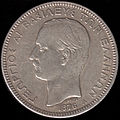 5 drachmae (1876)
5 drachmae (1876)
-
 1 drachma (1973) during the 1973-1974 military-controlled Republic
1 drachma (1973) during the 1973-1974 military-controlled Republic
-
 1 drachma (1978)
1 drachma (1978)
-
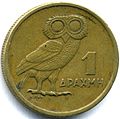 The design of this Drachma coin depicts the Owl of Athena and is reminiscent of ancient coins
The design of this Drachma coin depicts the Owl of Athena and is reminiscent of ancient coins
-
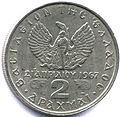 Two Drachma coin with a soldier standing in front of Phoenix
Two Drachma coin with a soldier standing in front of Phoenix
Banknotes
The first issues of banknotes were in denominations of 10, 20 and 50 drachmae, soon followed by 100, 500 and 1000 drachmae by 1956. 5000-drachma notes were introduced in 1984, followed by 10,000-drachma notes in 1995 and 200-drachma notes in 1997.
Banknotes in circulation at the time of the adoption of the euro were
- 100 drachmae (€0.2935), depicting Athena and Adamantios Korais
- 200 drachmae (€0.5869), depticing Rigas Feraios
- 500 drachmae (€1.47), depicting Ioannis Capodistrias
- 1,000 drachmae (€2.93), depicting Apollo
- 5,000 drachmae (€14.67), depicting Theodoros Kolokotronis
- 10,000 drachmae (€29.35), depicting George Papanicolaou and Asclepius
| Banknotes of the Greek drachma (circa AD 2000) | ||||||
|---|---|---|---|---|---|---|
| Image | Value | Equivalent in Euro (€) | Main Color | Obverse | Reverse | Watermark |
| 50 drachmae | €0.1467 | Blue | Head of Poseidon | Laskarina Bouboulina directing cannon fire at two Ottoman ships at Palamidi during the Greek War of Independence | Head of the Charioteer of Delphi | |
| File:100-drachmas-1978-front.jpg | 100 drachmae | €0.2935 | Brown and violet (obverse); Maroon, green and orange (reverse) | Head of Piraeus Athena; Christian Hansen's National and Kapodistrian University of Athens building | Adamantios Korais; Arkadi Monastery, Crete | Head of the Charioteer of Delphi |
| File:200-drachmas-1996-front.jpg | 200 drachmae | €0.5869 | Deep orange | Rigas Feraios; Feraios singing his patriotic song at lower right | Nikolaos Gyzis's Krifo scholio ("secret school") | Bust of Philip of Macedonia |
| 500 drachmae | €1.47 | Deep green | Ioannis Kapodistrias; Capodistrias's home on Corfu | Old Fortress, Corfu City | Head of the Charioteer of Delphi | |
| File:1000-drachmas-1987-front.jpg | 1,000 drachmae | €2.93 | Brown | Bust of Apollon of Olympia | Myron's Discobolus; Temple of Hera, Olympia | Head of the Charioteer of Delphi |
| 5,000 drachmae | €14.67 | Deep Blue or Purple and yellow-green | Theodoros Kolokotronis; Church of the Holy Apostles, Kalamata | Karytaina, Arcadia | Bust of Philip of Macedonia | |
| 10,000 drachmae | €29.35 | Deep purple | Georgios Papanikolaou; microscope | Asclepius | Bust of Philip of Macedonia | |
Gallery (banknotes)
-
 5 drachmae banknote (1912)
5 drachmae banknote (1912)
-
 5,000,000 drachmae banknote (1944) during the Axis Occupation hyperinflation period
5,000,000 drachmae banknote (1944) during the Axis Occupation hyperinflation period
-
 20 drachmae banknote (1955)
20 drachmae banknote (1955)
- 50 drachmae banknote (1964) 50 drachmae banknote (1964)
- 100 drachmae banknote (1967) 100 drachmae banknote (1967)
Encoding
In Unicode, the currency symbol is U+20AF ₯ DRACHMA SIGN. There is a special Attic numeral, U+10142 𐅂 GREEK ACROPHONIC ATTIC ONE DRACHMA for the value of one drachma but it fails to render in most browsers.
Restoration
See also: Greek withdrawal from the eurozoneThe Drachmi Greek Democratic Movement Five Stars which was founded in 2013, aims to restore the Drachma, as Greece's currency.
In popular culture
- The golden drachma is the main unit of currency in Rick Riordan's Percy Jackson & the Olympians fantasy adventure novel series, as well as its spinoff The Heroes of Olympus, the latter of which also features the Roman denarius.
- The drachma is used in the video game Assassin's Creed Origins, set in Ptolemaic Egypt, as the currency used by the player to purchase weapons, outfits and mounts. It is also used in the subsequent game Assassin's Creed Odyssey, set in Ancient Greece.
- The drachma is also mentioned in William Shakespeare's Julius Caesar in Mark Antony's famous "Friends, Romans, Countrymen" speech.
See also
- Commemorative coins of Greece
- Denarius
- Dirham
- Economic history of Greece and the Greek world
- Economy of Greece
- Greek euro coins
- Phoenix (currency)
- Seleucid coinage
Notes and references
- Notes
- [draːkʰmέː] is also attested.
- δράσσομαι, drassomai, "grasp"; cf.: δράξ, drax, and drachma itself, i.e. "grasp with the hand".
- "As much as one can hold in the hand".
- The word, whose meaning and translation is still uncertain, is 𐀈𐀏𐀔, do-ka-ma or 𐀈𐀏𐀔𐀂, do-ka-ma-i, found on the PY An 1282 and PY Wr 1480 tablets.
- Τριόβολον spelling variant is also attested.
- Ἡμιοβόλιον spelling variant is also attested.
- Greek: λεπτά; plural of λεπτόν, lepton.
- Minted but rarely used. Usually, prices were rounded up to the next multiple of 10 drachmae.
- ^ Not minted but remained legal tender (not in actual use in 2002).
- References
- ^ δραχμή. Liddell, Henry George; Scott, Robert; A Greek–English Lexicon at the Perseus Project.
- ^ δράσσομαι in Liddell and Scott.
- Shelmerdine, Cynthia W.; Bennet, John (1 January 1995). "Two Linear B documents from Bronze Age Pylos". Kadmos. 34 (2).
- "PY 1282 An (Ciii)"."PY 1480 Wr (unknown)", DĀMOS: Database of Mycenaean at Oslo, University of Oslo.
- Raymoure, K.A. "do-ka-ma-i". Minoan Linear A & Mycenaean Linear B. Deaditerranean.
- Philochorus: Scholion to Aristophanes, Birds 1106
- γλαύξ in Liddell and Scott.
- "The Inflation Calculator". westegg.com. Archived from the original on 1 July 2007.
- Thucydides, History of the Peloponnesian War 3.17.4.
- It was originally set at 1/6 drachma by Pericles, until Cleon raised it in 425 BC; see also Aristophanes, Knights (line 255) and Wasps (line 609, 684, 690, 788–790, 1121).
- Cf. footnote 18 of H. G. Dakyns's translation of Ways and Means: A Pamphlet on Revenues alias On Revenues (The Works of Xenophon, Macmillan, 1897). This footnote is quoting George Grote (Plato, and the Other Companions of Sokrates, vol. 3, J. Murray, 1865, p.597).
- British Museum Catalogue 11 – Attica Megaris Aegina
- Photo gallery of Tetartemoria and other small Greek coins
- Aristotle, Athenian Constitution, 10.2
- Drachma, The Catholic Encyclopedia, Volume V. Published 1909. New York: Robert Appleton Company. Nihil Obstat, 1 May 1909. Remy Lafort, Censor. Imprimatur. John M. Farley, Archbishop of New York
- Luke 15:8–10
- "The first modern drachma coins catalog". Retrieved 22 June 2013.
- "The Greek Financial Crises: Getting by with the Half-Drachmai | PMG". www.pmgnotes.com.
- "Banknote Index". banknoteindex.com. Retrieved 1 February 2019.
- ^ "Chronology (1928–2003)". Bank of Greece (in Greek). Athens. Retrieved 9 May 2020.
{{cite web}}: Check|archiveurl=value (help) - "Archived copy". Archived from the original on 4 February 2005. Retrieved 12 January 2005.
{{cite web}}: CS1 maint: archived copy as title (link) - "History of Greek Banknotes". Greekcurrency.110mb.com. Retrieved 17 November 2013.
- fileformat.info Entry for (U+10142)
- "Political Party Drachma 5 Launched". greekreporter.com.
- https://shakespeare-navigators.com/JC_Navigator/Julius_Caesar_Act_3_Scene_2.html#241
External links
- Overview of the modern Greek drachma from the BBC
- Historical banknotes of Greece (in English and German)
| Preceded byGreek phoenix | Greek currency 1832–2001 |
Succeeded byeuro |
| Currency symbols | |
|---|---|
| Circulating | |
| Obsolete and historical | |
| Cryptocurrency | |
| Generic placeholder | |
| Ancient Greek coinage | |
|---|---|
| Drachmae | |
| Stater |
|
| Obol |
|
| Morion | |
| Standards | |
| Euro topics | |||||||||
|---|---|---|---|---|---|---|---|---|---|
| General | |||||||||
| Administration | |||||||||
| Fiscal provisions | |||||||||
| Economy | |||||||||
| International status | |||||||||
| Denominations |
| ||||||||
| Coins by country with minting rights |
| ||||||||
| Non-EU territories using euro per agreement without minting rights | |||||||||
| Potential adoption by other countries | |||||||||
| Countries and territories using euro unilaterally | |||||||||
| Other extant EU currencies |
| ||||||||
| History |
| ||||||||
| Symbols of Greece | |||||
|---|---|---|---|---|---|
| National symbols |
|  | |||
| Other symbols |
| ||||
| Natural | |||||
| Monuments | |||||
| Music | |||||
| National poets |
| ||||
| National epics |
| ||||
| Cuisine | |||||
| Patron Saints/Religion | |||||
| Former national symbols | |||||












